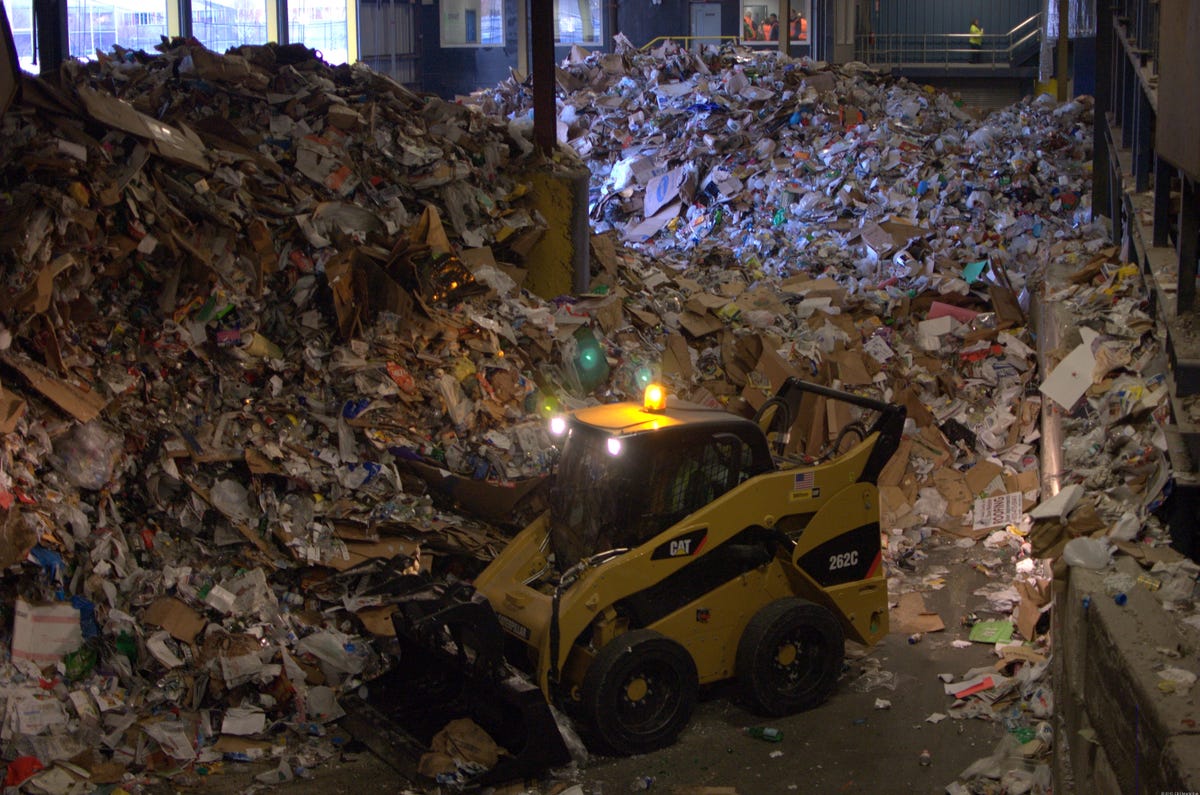Digging through a high-tech recycling center (photos)
<p> A waste recycling center uses a series of machines to automatically sort material to enable single-stream recycling for consumers.</p>

Whole lot of trash
CHARLESTOWN, Mass.--Tucked inside an industrial park in this Boston neighborhood is a single stream recycling center run by Casella Waste Services. The facility was opened in 2009 and has seen growth in customers and the recycling rates that they are getting.
With single stream recycling, people put all types of recyclable material into a single container. The company adopted an automated system which separates 75 percent of the material that comes in, using a combination of techniques.
See related article: Machines eyeball trash for single-stream recycling.
Spinning disks
Unsorted recycling material is put onto a conveyor belt and then passes over the disks you can see here. This separates the cardboard, a valuable material, from the rest since it can't fall through the cracks. The rest then goes to presorting.
Presorting
Here workers do what is called presorting, which is basically identifying things that do not belong in the recycling waste stream. They pull out items that don't belong, such as pots and pans, chains, and garbage that should go to a landfill or incinerator. Plastic bags, which can be recycled at supermarkets, are a problem in particular because they can gum up the operation and stop the conveyor belts.
Recyclers sell their material to mills, which use paper or plastic as a "feedstock" for new products. If there are too many contaminants, a batch from a recycler can be rejected.
Pots and pans
Here are some examples of things that people should not have put into recycling. Casella Waste Service's Charlestown facility sends trash to a landfill, and metal is separated and given away for scrap.
Glass separator
This circular drum is how most glass is separated from the stream of unsorted recycling. The drum spins, causing glass to break and drop to a collector below, according to the plant manager.
Cardboard separated
There are three separate lines to pull out different types of fiber from home recycling bins, with cardboard separated from the mixed stream right away. Cardboard is thick and high-fiber compared with newspaper, which makes it valuable to paper companies because fiber material gets thinner each time it is recycled.
Postpaper stream
Belts move quickly at the Charlestown single stream recycling center with each belt holding less and less of the original mixed recycling refuse. Cardboard and much of the paper is automatically separated by rolling it over disks and letting heavier material fall to a belt below. Here mostly plastic and aluminum travels--at high speeds--to the next phase, where optical readers identify different types of plastic.
Flying along
There are optical readers on the side of this fast-moving belt that can recognize what types of plastic are flowing across. The machine uses more than 100 parameters to identify an object, including color, shape, and density. Once it recognizes that something is a particular type of plastic, it sends a jet of air a few seconds later. As the photo here shows, that jet of air sends certain types of plastic containers to a separate bin. The rest drops below.
Collected plastic
After the optical reader shoots different types of recyclable plastic, they are collected in separate bins, such as this one. Elsewhere at the facility are piles of different types of plastic used for laundry detergent bottles or juice containers.
Aluminum belt
Aluminium is automatically separated from the mix of plastic and aluminum with a device that gives off a kind of magnetic field called an eddy current. As items reach the end of a conveyor belt, aluminum items are moved by the gravitational field a bit farther than plastic ones and fall into a separate bin. Tin, too, is separated automatically by using a magnet earlier in the process.
Reuse
Recycled plastic is already used in many different products, such as carpet and clothing, as shown here. Recycled plastic is melted into pellets, seen in the small plastic bags in the middle, which are the feedstock for new products. Recycling saves energy and reduces the need to extract virgin materials.
Bales of trash
The single stream recycling center in Charlestown treats hundreds of tons of refuse every day. It uses a compactor to create large bales which are sold to mills as feedstock for new products. Some of the trash they handle can't be recycled--that's also baled up, and sent to a landfill.

